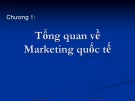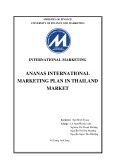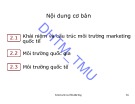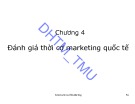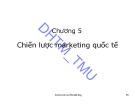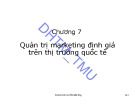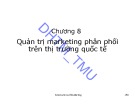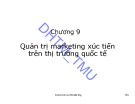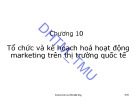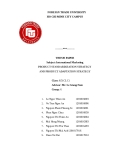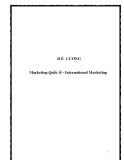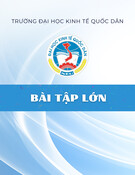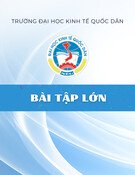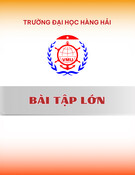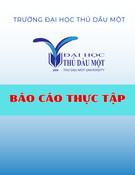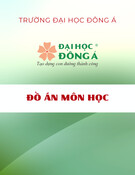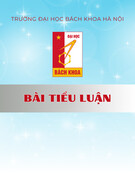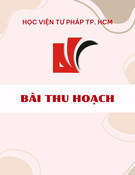MINISTRY OF FINANCE UNIVERSITY OF FINANCE AND MARKETING
INTERNATIONAL MARKETING
ANANAS INTERNATIONAL MARKETING PLAN IN THAILAND MARKET
ễ
ng
ễ ễ ươ ng ươ Lecturer: Ngô Minh Trang Group : Lê Nguy n Mai Anh ị Nghiêm Th Thanh Ph ị ươ Nguy n Th Thu Ph ọ Nguy n Ng c Thu Ph ng
Vũ Trung Anh Sang
TABLE OF CONTENTS
LIST OF TABLES
LIST OF FIGURES
1. Introduction
1.1. Brief overview of the company
Ananas was first launched in 2012, is a brand belonging to Footwear
Corporation Dong Hung Group the "big man" in the shoemaking industry. However,
the company's marketing strategy at that time was not effective, causing the brand to
fail for the first time. It was not until 2017 that Ananas finally turned the tables, started
to be recognized and held its position among the young generations.
As Ananas's target customers aging from 18 to 25 who are energetic, dynamic
and always in motion, Ananas brand’s top priority is customer's convenience and
comfort when wearing our shoes but still trendy and being able to reflect their own
personalities. Hence, "high quality" and "reasonable price" are core values that we
offer to our dear customers.
With the message DiscoverYOU, Ananas wants to remind everyone that
"Whatever you do, you need to know yourself and know what you want". The more
you understand who you are, the easier life will be. Ananas is also on the journey to
discovering the brand itself, finding our originalities, and building our own path.
1.2. Company’s main product
Ananas product's are vulcanized shoes and sneakers. Vulcanized is a long
standing shoe manufacturing method, reflected in vintage shoes with rubber soles and
minimalist designs such as Converse Chuck Taylor All Star, Vans Old Skool. This
type of shoes is considered an everyday sneakers for its basic design and concept.
Customers can wear it to school, to work, friends meetings or even their skateboard
practices. By using this material and design, Ananas wants to integrate sustainability
into our products, focusing on the original attributes of a shoe but still keeping up with
the current fashion trends, as it is the brand lifestyle that we are aiming for. All of
Ananas products are manufactured by our parent brand Dong Hung Group and
directly distributed at Ananas stores in Ho Chi Minh City. In addition to the 4 main
shoe lines currently available in stores which are Basas, Vintas, Urbas and Pattas,
Ananas also sells other clothing products.
5
1.3. Target country: Thailand
According to the ASEAN Consumer Survey conducted by HKTDC Research,
ASEAN consumers, including those in Thailand, are willing to spend more on better
quality products and have a strong sense of personal style. For international brands,
Thailand is a key market among the developing Asian countries, not only because of
its growing demand from the emerging middleincome class, but also the country’s
flourishing tourism sector. Also, Thailand is a South East Asian country with close
proximity to Vietnam. Hence, the two countries partly share different things in
common including climate characteristics, genetic traits, religions and most
importantly, culture.
2.Research Methodology
Secondary data resources on Internet
3.Situational Analysis
3.1. Company analysis
Ananas was founded in 2012 under Dong Hung Footwear Group. Dong Hung
Footwear Joint Stock Company was established on October 1, 1992 with the mission
to provide Vietnamese and international consumers with highquality footwear
products at reasonable prices. With our modern factories and advanced shoe
production process, Dong Hung Footwear Group aspires to be a companion of
consumers around the world in their journey of discovering life.
Moreover, Dong Hung Footwear Group has more than 20 years of experience
in manufacturing vulcanized shoes and being the main manufacturer for not only
domestic but also foreign major brands such as Puma, Reebok and Burberry. Over
nearly 30 years of development, Dong Hung is in the top 30 Vietnamese leather shoe
manufacturing enterprises, with a total annual export turnover of more than 150
million USD and more than 10 million pairs of shoes. Therefore, we are confident that
Ananas possesses the ability to provide customers with highquality products which
absolutely not inferior to any other brands.
6
3.2 Organization Assets and Skills
❖ Assets:
Over the past 3 years, Ananas has 9 stores in Ho Chi Minh City. Customers in
other cities and provinces could also purchase our product through Ananas's
website and Facebook fanpage. All Ananas products are made by parent brand
Dong Hung footwear with more than 20 years of experience in footwear
manufacturing and have cooperated with many large and small, both domestic and
foreign shoe brands. Currently, Dong Hung Group has 5 member companies, 2
affiliated branches, and a joint venture company associated with business
components, including: shoe production, shoe sole production. , shoe production
supporting stages, logistic activities, footwear supply and distribution on e
commerce channels, retail stores etc.
❖ Skills:
Ananas and parent firm Dong Hung Footwear Group has constantly
researched and updated the latest technology, manufacturing methods. With
factories meeting international standards, modern production processes, product
safety are guaranteed by limiting chemicals used in production in accordance with
EC 1907/2006 (REACH). Dong Hung Group also has long experience in the field
of footwear production and excellent human resources with professional skills.
Before being delivered to consumers, each Ananas product has to go through a lot
of meticulous steps from product design, stitching and evaluation to create perfect
shoes with the best quality. All manufacturing factories are equipped with
professional wastewater treatment systems in compliance with the Vietnam laws
and regulations.
7
3.3. Market Analysis
3.3.1 Business Environment Analysis
3.3.1.1 Political and Legal Environments
Thailand is one of almost 40 constitutional monarchies that exist in the world
today. Normally, an elected Prime Minister heads the government, while the head of
state is the hereditary monarch.Thailand is one of almost 40 constitutional monarchies
that exist in the world today. Normally, an elected Prime Minister heads the
government, while the head of state is the hereditary monarch. In Thailand, the King
exercises his legislative power through the Parliament, executive power through
Cabinet and judicial power through the courts.
Thailand is now facing continuous antigovernment protests by students
demanding political reforms that also include the role of the monarchy in politics. The
protests were initially triggered by the dissolution of the Future Party (FFP) in late
February 2020, which criticized Prayut, changes to the Thai constitution. Persistent
political tensions can undermine the credibility and effectiveness of the institutional
framework, especially if they hinder the ability of authorities to effectively enforce
macroeconomic policy such as support finance during the Covid19 epidemic. From
there, it could undermine the interest of foreign investors and cause difficulties for
businesses to thrive in Thailand.
The Foreign and Commonwealth Office (FCO) assesses that terrorists are very
likely to try to carry out attacks in Thailand. Since 2004, there have been almost daily
attacks in Thailand’s deep south, including arson, bombings and shootings. Targets
have included civilians and members of the security forces, government offices,
tourist hotels, discos, bars, shops, marketplaces, supermarkets, schools, transport
infrastructure and trains.
Corruption hinders economic and social development also needs to be taken
seriously. Thailand ranked 99th with the Philippines (out of 180 countries and regions)
in the Corruption Perceptions Index 2018 of Transparency International on Corruption
8
2018 (Bangkok Post, 2019). Most sectors in Thailand are at high risk of corruption,
and as a result, a lot of work is needed to deal with it.
However, Thailand’s periodic political volatility tends not to affect daytoday
business operations. Although Thai politics is sometimes unstable, the administration
of the country is very sound and all political parties in Thailand, without exception,
are probusiness.
*Legal
Consumer Protection Act (1979) The right to be informed Goods, domestic and
imported, must bear appropriate labels description, name or trademark of
manufacturer, location of manufacturer, information of the goods, and marks
indicating countries of origin (imports) Labels are to be accurate and not misleading.
Advertisement must be truthful, honest, decent.[5]
Unfair Contract Term Act (1997) Protects consumers with little ability to negotiate
or negotiate
Commercial Competition Law (1999) Maintaining free and fair competition of
markets and discouraging business operators from engaging in anticompetition
activities
3.3.1.2 Regulatory Environments
Thailand belongs to the 10member Association of Southeast Asian Nations
(ASEAN), a regional freetrade and economic bloc comprising a total population of
600 million.
Thailand remains an attractive destination for foreign investors and business
owners seeking out new markets to open a new or expand an existing business.
Nevertheless, those who wish to establish majority or wholly foreignowned business
entities need to be aware of Thailand’s laws and regulations regarding foreign
investment.
● Limits on Foreign Control and Right to Private Ownership and
Establishment
9
A foreign entity seeking to engage in any of these business activities must first
obtain a Foreign Business License (FBL) from the Foreign Business Committee and
the DirectorGeneral of the Department of Business Development (DBD). There are
also cases for exemptions or special permissions from the Board of Investment or
Industrial Estate Authority of Thailand, as well as through freetrade agreements and
treaties between Thailand and certain nations. The FBA details the types of business
activities reserved for Thai nationals. Foreign investment in those businesses must
comprise less than 50 percent of share capital, unless specially permitted or otherwise
exempt.
Restricted businesses in this list include: accounting, legal, architectural, and
engineering services; retail and wholesale; advertising businesses; hotels; guided
touring; selling food and beverages; and other servicesector businesses. A foreign
company can engage in List 3 activities if a majority of the limited company’s shares
are held by Thai nationals. Any company with a majority of foreign shareholders
(more than 50 percent) cannot engage in List 3 activities unless it receives an
exception from the Ministry of Commerce under its Foreign Business License (FBL)
application.
Aside from these general categories, Thailand does not maintain a national
security screening mechanism for investment, and investors can receive additional
incentives/privileges if they invest in priority areas, such as hightechnology
industries.
10
● Laws and Regulations on Foreign Direct Investment
The Foreign Business Act (described in detail above) governs most investment activity by nonThai nationals. Other key laws governing foreign investment are the Alien Employment Act (1978) and the Investment Promotion Act (1977).
● Competition and AntiTrust Laws
The Office of Trade Competition Commission (OTCC) is an independent agency and the main enforcer of the Trade Competition Act B.E. 2560 (2018). The OTCC comprises seven members nominated by a selection committee and endorsed by the Cabinet.
The government has authority to control the price of specific products and services under the Price of Goods and Services Act. The MOC’s Department of Internal Trade administers the law and interacts with affected companies.
3.3.1.3 Economic Environments
Thailand is the second largest economy in Southeast Asia after Indonesia.
According to IMF, it is expected that growth will be at a moderate rate, accepting all
stable values in the country. Investment firms are forecast to remain the main driver of
growth over the next few years, in line with the host company's infrastructure plan to
attract private individuals. The capital Bangkok has become the centre of economic
activity and the most prosperous part of the country, accounting for about 60% of
national GDP. Thanks to its good infrastructure, the city is competing with Singapore
to become a regional hub for air travel within Southeast Asia. The relationship
between Vietnam and Thailand is constantly developing steadily and well in all fields,
especially in the economic and commercial sectors. Vietnam Thailand is a member
of many regional and international forums, such as: ASEAN, ASEAN Economic
Community (AEC), AsiaPacific Economic Cooperation (APEC). According to ITPC,
Thailand is currently the largest trading partner of Vietnam in ASEAN. Particularly,
Vietnam's merchandise exports to Thailand account for about a fifth of the total
exports to ASEAN.
Inflation drops to 0.7% in 2019 and is estimated to drop to 1.1% in 2020 and
will reach 0.6% by 2021 (IMF forecasts the World Economy in April 2020). Public
11
debt remains relatively stable in 2019, according to IMF estimates of 42.4%, although
it is expected to increase in 2020 and 2021 to 43% and 43.8%, respectively. Despite
high debt, household use standards, amounting to 49% of GDP in 2019 (Central Bank
of Thailand), is still forecast to be high, reflecting real income levels. The National
Strategic Plan (20172036) focuses on improving the business environment, enhancing
TABLE 3.1 GDP Thailand
the country's competitiveness and longterm economic efficiency.
https://www.nordeatrade.com/en/explorenewmarket/thailand/economicalcontext
● Income distribution
Although wealth has increased in Thailand, not everyone has received a share
of this growth. Specifically, 91.7% of adults are in the group of assets below $ 10,000,
7.5% in the group from $ 10,000 to $ 100,000, and 0.7% in the group from $ 100,000
to $ 1 million. Only 0.1% are members of the wealth group over $ 1 million.
Thailand's middle class is emerging and is expected to make up about 13% of all
households. This translates into the high value of income inequality of 90.2 on the
Gini coefficient.
● Average Salary
Percentage of people 5% 12% 23% 58% 82% Earn this salary or more THB 3,733,000 THB 2,663,076 THB 1,788,268 THB 815,776 THB 476,011
12
TABLE 3.2 – Average Salary
94% 98% THB 249,070 THB 123,380
● Consumer spending
Growing domestic income is generating optimism among the population and
increasing consumer demand for a wide variety of products. With the increase in
income, consumers especially the richer ones have spent more on experiences, such
as eating out and traveling. The luxury market is also growing domestically. When it
comes to buying luxury, consumers prefer to buy directly than buy online, as they say
they can't make any buying decisions without seeing the product in person.
Price, quality and availability of service are the main selling factors in
Thailand. However, consumers are willing to pay more for the brands they love, and
they rarely switch brands even if the prices are better. Thai consumers are the most
brandconscious and loyal in Southeast Asia. They also spend more than their
neighbors, which is reflected in their higher debt levels. Furthermore, consumers tend
to like and shop impulsively, instead of saving their money as is common in other
Southeast Asian countries.
● Household Consumption Expenditure
TABLE 3.3 Household consumption expenditure
Percentage 39.6% 29.3% 10.9% 3.8% 3.5% 2.8% 2.5% 1.3% Sector Food and beverages Housing Transport Energy ICT Clothing and footwear Personal care Health
● Inflation rate
13
ả ộ ươ (http://congthuong.hochiminhcity.gov.vn)9/7/2020B n tin b công th ng.
According to TPSO, Thailand's CPI, a measure of overall inflation, in June fell
1.57% from the same period last year, after falling 3.44% in May the highest drop in
nearly 11 years. Generally for the first six months of this year, Thailand's overall
inflation was 1.13% and core inflation was 0.32% (Thailand's core inflation in June
was 0.05%). Thailand's deflation is likely to be worse than initially expected, after
the Southeast Asian country's consumer price index (CPI) fell for the fourth
consecutive month in June 2020.
● Unemployment
Thailand's unemployment rate was 0.69% in 2019 according to the latest data
from the World Bank. The Thai unemployment rate increased by 0.02% in 2019
compared to 0.67% in 2018. Statistics of Thailand's unemployment data up to 2019 are
in tables and graphs. During this period the unemployment rate in Thailand peaked in
the year with 3.40% of the working age population without a job. Lowest in the year
with an unemployment rate of 0.49%.
14
FIGURE 3.1- Unemployment Rate
● Interest rates (base lending rates)
On November 6, the Central Bank of Thailand (BoT) cut its prime rate down to
1.25%; This is the second basic interest rate cut in the past three months to boost
economic growth and curb the baht's appreciation against the dollar. Five out of 7
members of the Monetary Policy Committee under BoT voted for this decision.
The Thai government is stepping up the monetary and financial management
measures to boost the economy, which is currently at low growth. The Thai baht's
value has risen by around 9% against the dollar over the past year and has become
the most bullish currency in emerging markets. This trend has constrained
Thailand's exports and tourism, with an economy quite dependent on the trade
sector.
15
According to the new data released by the Ministry of Commerce of Thailand,
in October, the consumer price index (CPI) of this country increased by 0.11%
over the same period last year, lower than the previous month. and make the
inflation rate in this Southeast Asian country at the lowest level in 2 years.
→ Overall, the economy is in good condition thanks to the current account
surplus, adequate foreign exchange reserves, low unemployment, and relatively
low public debts enabling the use of fiscal policy as an economic stimulus. Still,
all sectors of the economy should work on risk management and boost
competitiveness in the face of today’s structural changes such as the use of
automation in many industries, consumers’ changing behavior in everyday
spending, and higher business competition from both domestic and international
firms. Despite the Thai economic stability, these factors may have a negative
impact on households, labors, and businesses that cannot adapt in time.
3.3.1.4 Social and Cultural Environments
❖ Social
The total population of Thailand, as of December 2019, is around 69 million.
There is no official state religion in the country; however, Buddhism is the most
widely practised religion. Other major religions are Islam, Christianity, and Hinduism.
The life expectancy for men is 71 years, while 79 years for women. The major
language in Thailand is Thai.
The people of Thailand are generally very friendly. They are very hard working
as well. Thailand is a diverse country and tensions between ethnic groups are few and
far between as people love to live freely and practise their faith as they wish.
Many Thai women are very educated, and tech savvy; hence wellpaid. Thai
consumers are very brand conscious and do not mind paying some extra for their
favourite brands. The demand for luxury products such as smartphones, jewellery,
designer watches & sunglasses, and luxury cars is on the rise. However, Thai society
16
faces some big social challenges. For example, adolescent pregnancy, ageing
population, human trafficking, and corruption to name but a few in this regard.
❖ Cultural
Language:
The main language used in Thailand is simply called Thai, although it can also
be referred to as Siam or Central Thai. Thai is the official language of the country and
is widely used in government and education. Thai is part of the TaiKadai family, and
is closely related to Lao, the main language spoken in Laos, so the two can understand
each other for the most part.
There are different dialects of Thai that are spoken across different regions of
the country, including Southern Thai and Northern Thai. There are also a wide range
of minority languages spoken across Thailand, including Khmer, Malay and various
Chinese dialects, in addition to many tribal languages, many in that number are in
decline.
Religion:
Religion is a core feature of Thai life. While Buddhism is regarded as the
national religion, practised by more than 90 per cent of the population, Islam,
Christianity, Hinduism and other faiths are also represented. Thailand has nearly
94.6% Buddhism, 4.3% Islam and 1% Christianity, mainly belonging to the
Theravada school (including the Traditional Thai Forest and the Dhammayuttika
Nikaya and Santi Asoke sects). In addition, there are also Muslim minorities in
Thailand (56%), Christians (1%) and other religions.
Buddhism in Thailand is strongly influenced by the traditional beliefs related to
ancestral and natural spirits, which have been incorporated into Buddhist cosmology.
Most Thais have installed divine houses (Thai: ศศศ ศศศศศศศ; RTGS: san phra
phum), miniature houses outside their dwelling, where they believe that family spirits
live. They offer food and drink to these souls to make them happy. If these souls are
unhappy, it is believed that they will dwell in the house and cause chaos. These god
17
houses can be found in public places and on Thai streets where the public makes
offerings.
Customs:
One of the most distinctive features of the Thai custom is bow (Thai: wai),
almost like the way of bowing by the Indians (Hindi: namaste). This gesture is used
when meeting, breaking up, or confirming, with various forms depending on the
person's social position, but in general it is usually a ceremonylike gesture with hands
clasped and head down.
Another Thai custom is bun khun, which is indebted to the births, as well as
guardians, teachers, and people who have taken care of them. This custom includes
emotions and actions in reciprocal relationships.
In addition, stepping on Thai baht is also extremely disrespectful because the
first image of the king appears on Thai coins. When sitting in temples, people should
avoid pointing at pictures and statues of Buddha. Temples in Thai residences are built
in such a way that the feet are not pointed directly to the symbols of worship for
example, do not place a temple for a bed if the house is too small, there is no other
place to place a shrine.
Thailand is a collectivist society, which dictates that the needs of the group are
placed ahead of those of the individual. Subtlety and indirect forms of communication
are highly valued in Thai society which, as in the case of many others across Asia, is
hierarchical. Individuals are viewed as being either higher or lower in status,
measured between one another in relative terms – younger or older, weaker or
stronger, junior or senior, subordinate or superior, and rarely equal. As a result, young
Thais grow up needing to learn appropriate behaviour within the confines of the
existing hierarchy, taught to recognise the difference between ‘high place’ and ‘low
place’, particularly in regard to the roles in society of adults and children, or teachers
and students. In such a hierarchical society, status is important. Such a ranking can be
determined simply by someone’s clothing and general appearance, their age or job,
education, family history, as well as their wealth and social connections. Status
18
dictates that subordinates will generally listen to and accept advice and direction from
his or her superior without question. But this courtesy imposes on superiors an
unstated obligation to lead and to be mentors in return.
3.3.1.6 Technological Environments
Thailand is gradually becoming a country with advanced technology.
Government encourages new organizations to adopt technology. The investment of
Thai companies into new change and corporate infrastructure is also worthy of
attention. Therefore, the country is expected to witness an increase in ecommerce and
similar technology activities in the coming years.
Thai companies now provide technology products and services overseas. For
example, CCS Advance Tech (a Thai company) manufactures and supplies aerospace
and aerospace components to global companies including Boeing and Airbus (Lowe,
2019). Thailand is also the Southeast Asian country at the forefront in the use of social
media. Facebook, YouTube, Line (a Japanese company), Instagram and Twitter are
the most used social media in the country. However, trustworthy activities are mainly
focused on Bangkok.
3.3.1.7 Natural Environments
Thailand is a country rich in natural resources, has played an important role in
supporting local livelihoods and promoting economic growth. Management of natural
resources and the environment has not been effective, and has revealed the conflict
between environmental conservation and economic development. Natural disasters
tend to occur frequently, threatening agricultural production, food and energy security,
health and quality of life. Rapid economic development has affected natural resources.
Biodiversity loss, air and water pollution, deforestation, water scarcity and
desertification are some of the major environmental challenges facing Thailand today
and protecting the environment has become one of the top priorities of the country.
19
3.3.2. Nature of Demand
Sneakers and athletic shoes play an important role in footwear. Thai people,
especially young people, normally like to wear casual shoes and simple sandals, and
many of them keep sneakers in their shoe cabinet to wear both when doing exercise
and in their daily routine, as the athleisure trend continued to be strong in 2019:
Some people tend to wear sneakers to work, as many offices allow a relaxed
dress code on some days. Given that consumers are also participating in more sports
activities, they are therefore interested in purchasing sports footwear or sneakers in
response to their healthy lifestyles.
A number of men are interested in purchasing sneakers or sports footwear, they
wear sneakers more often, pairing casual street sneakers or gym sneakers with their
daily outfits, including jeans, shorts or trousers. So, when fashion style influences
purchases, the decision becomes more complicated.
In terms of distribution:
Footwear specialist retailers, mainly located in department stores and shopping
centres, are the places consumers normally look when wanting to buy a pair of shoes.
Footwear sections in shopping centres provide a range of brands for both men and
women, and special promotions and price discounts are usually offered from timeto
time. Nonetheless, when it comes to sports shoes or sneakers, consumers tend to get
products at sports goods stores in shopping centres. Some brands provide exclusive
shops with independent space, whilst others are offered at sports footwear distributors,
namely Sports World, Super Sports, Carnival Store, SneakaVilla and Hoops Shop.
Distribution is expanding.
As internet retailing is being developed, certain brands have developed their
own websites for online transactions, whilst some brands rely on other retailers. There
is an emerging trend of using the internet in footwear in Thailand. This is either as an
20
alternative shopping channel for digitalminded consumers, or the use of digital
marketing strategies with the purpose of getting connected to a modern target
audience.
IMPACT: Due to the strong athleisure trend amongst Thai consumers, their
preference tends to be shifting towards casual fashion inspired by sports, as well as
urban street fashion trends. Gym sneakers, running shoes, training shoes, as well as
casual street sneakers, are becoming more popular and eroding the shares of the other
types of footwear available in the marketplace, such as leather flats, high heels, boat
shoes, loafers and boots.
3.4. Competitor Analysis
❖ Converse
Converse is an American shoe company and was established in 1908. It creates brand trends in footwear, apparel and ice skates. Since 2003, it has become a subsidiary of Nike. Currently, Converse has been present in Thailand with more than 20 stores concentrated in the big city of the Golden Temple country today.
According to the demographic segment, the market has been divided into three segments: under 13 years old, group 1319 years old, age group 2035 and over 35 years old, including both men and women. Income is also divided into no income (students) and middle and upper class people. According to the psychology segment, Converse targets ambitious people who are materialistic, receptive and visual. Converse has also analyzed people's activities on the web and targeted behavioral segments like fashion, outdoor sports enthusiasts, and more.
This brand is positioned as a retro modern subculture and is a classic shoe for the younger generation. High quality, carefully selected price range, the picture has got a good position in the minds of buyers.
❖ Vans
Vans is an American manufacturer of skateboarding shoes and related apparel, started in Anaheim, California, and owned by VF Corporation. The company also sponsors surf, snowboarding, BMX, and motocross teams.
21
Since the late 1960’s Vans has targeted Core Sports athletes, enthusiasts and followers and this has not changed much to today. With significant diversification of their product range Vans nowadays target males and females between the ages of 15 24 years who have an interest in action sports and lifestyle fashion.
Vans however can cater to a much broader market with over 200 shoe styles, size from infants to adults, as well as apparel items and accessories including watches, belts, hats, bags and clothing. Vans heavy involvement in the youth music scene with the Vans Warped Tour has added another dimension to their target market, while still maintaining the same youth culture and style.
❖ Rompboy
Rompboy was founded by Tanan Boonyatanapiwa. The brand started as a clothing label but shortly finds its way into the streetwear game with great success. Heavily influenced by tennis and badminton shoes from the 1960s, Tanan Boonyatapiwat handmade his first pair of shoes in 2015.
Each pair highlights the vintageinspired design made by hand from highgrade material and the craftsmanship of the team of experienced shoemakers.
At first, the brand offered only a limited number of shoes and made them only available through the online store. The vintage styling and minimalistic appearance added with appealing little details on each pair sparked extreme interest among sneakerheads, causing the shoes to sell out in no time and cementing the brand’s reputation in the realm of sneakers.
Building on their success, Rompboy now has its outlet and new product lines in fashionable leather shoes and student kicks.
❖ Mitzahai
Mitzahai, translating to friends or companions in Thai, is a Thai footwear brand that focuses on vintagestyle sneakers inspired by the events of World War 2 from the 1940s. Originally a footwear company focusing on vintagestyle sneakers, the brand has since expanded its range of products to include comfortable tees, shirts and hats.
Mitzahai’s footwear and apparel are sold at CAZH outlets in Siam Discovery and ICONSIAM. It also offers worldwide shipping for purchases made via its online store.
22
The assortment of color options allows you to mix and match Mitzahai shoes with any style of clothing. Their sneakers come in all types from regular running shoes to high tops. Each creation features an iconic wavy pattern on the curved toe cap made from rubber and lightweight materials that are easy to put on and extremely durable. The iconic gimmick of a printed brandname in Thaistyle font incorporated on the designs of their upper and soles.
❖ Truly
Another sneaker brand for all the fashionable men out there. Truly comes with a healthcentric concept that pays attention to the wellness of your feet and making sure that you get the most comfortable yellowcolored sole for one foot and a redcolored sole for the other foot, a creative gimmick that is still talked about today.
Furthermore, the GUM collection uses pure Para rubber and unbleached canvas fabric that offers superb softness and flexibility, reducing stress on the feet and helps with shock absorption as you walk. Materials used for every collection are all homegrown, with the meticulous production process ensuring that an international standard of quality is met in every pair.
4. SWOT Analysis
● STRENGTH:
● WEAKNESS: Lack of experience in new markets, especially international (Thailand) markets.
A new brand in customer's 20 years experience of the shoe factory has cooperated with many famous brands such as Puma, Reebok, Keds, Burberry, …
perception
Ananas has yet to build relationships
with partners in Thailand
Ananas flagship product is the vulcanized shoe with a minimalist design that is easily combined with many different types of outfits.
Website with many eyecatching colors, bringing a youthful and dynamic look
Colors range from monochrome to
ombre. This makes Ananas no
need for sophisticated motifs but
23
still able to conquer the most
demanding customers. ● OPPORTUNITIES ● THREATS
Thailand has undergone rapid Concentrated spending patterns due
urbanisation with a sustained to high household debts and a slow
improvement in household recovery of household income
incomes, this will support the Uncertainties from the upcoming
growth of consumer spending on national election which will
discretionary items, such as significantly affect consumer and
lifestyle products and services investor confidence as well as future
The rapid adoption of ecommerce economic policy.
in Thailand help the company Various problems of national
reach target customers more easily security have been increasing at an
and less costly alarming rate due to political unrest,
Thai society maintains good terrorism, economic crisis and
values and culture. These factors international competitions
contribute toward social cohesion There is still a lack of law
and reduce the negative influences enforcement to prevent piracy.
of modernization and conflicts in Thailand is becoming an ageing
Thai society. society due to changes in population
structure, characterized by the
increase of older persons while the
size of younger population and
workforce decrease
Severe natural and manmade
disasters are likely to have greater
impacts in the future.
24
5. Objectives
With being a new foreign product in the market and facing competitors that are local and foreign brands that already have a presence and a certain market share. The basic and most important goal when Ananas enters the Thai market is increase market penetration and increase product awareness, attract new consumers to use products that combine strong and continuous communication. 6. Recommended Marketing Strategy
6.1 Target Marketing Identification and Segmentation Strategy
Demographics
● Gender: Both male and female ● Age: 18 25 ● Income: >= 2604.27 THB/month (86.30 USD/month) ● Occupation: College students and newcomers to the workforce
Geographics: Urban area Bangkok Psychographics:
● Personality: Youthful, dynamic and active ● Lifestyle: Extrovert, enjoying experiences and participating in outdoor
activities, having a healthy lifestyle
Behavior:
● Buying places: supermarkets, shopping centres, online ● Behavioral Occasion: Regular occasion: go to school, work or hanging out Special occasion: As gifts on important occasions such as birthdays,
anniversaries, ...
● Benefit: Looking for a shoe that is comfortable and suitable for school, work or hanging
out.
No shoelaces Easy to slip on and off Easy to map. ● Usage rate: medium or heavy (use everyday) ● User status: daily user
6.2 Marketing positioning
Reasonable price Good quality; Good customer service
25
6.3 Market Entry Strategy:
→ Exporting:
● Direct sales (ecommerce website) ● Use of an intermediary (retailers)
7. Marketing Mix Strategies and Tactics
7.1 Product
7.1.1. Core product: Vulcanized shoes
FIGURE 7.1- Vulcanized shoes
Overall, Vulcanized shoes overall have two main parts: Upper and Sole in which Upper are all the components located in the upper body while Sole is the rubbermade foundation below.
(1) Vamp: toe box the front part of the shoe, a hard covering to protect the
toes in a shoe
(2) Tongue: A shoe tongue is a strip of leather or other material located under the laces of a shoe. The tongue sits on the top center part of the shoe on top of the bridge of the foot. It's attached to the vamp and runs all the way to the throat of the shoe.
(3) Stamp: The pineapple logo stamp is sewn or heatpressed directly on the
tongue.
(4) Eyestays: is the part that contains 2 rows of shoelace holes. Shoes may or
may not have these depending on the intentions of the design.
(5) Eyelets: Eyelets are usually holes in a shoe through which shoelaces are threaded, allowing the shoes to be tightened. Eyelets are found at the throat of the shoe which is located along the top of the foot
(6) Stitching: decorative stitches used to attach discrete parts together (7) Laces: shoelace the composition is familiar and can be changed easily. (8) Aglets: a metal or plastic tube fixed tightly around each end of a shoelace.
26
(9) Heel counter: heel counter heel fixer for the shoe (inside) and heel
decoration (outside).
(10) Heel strap: also known as rear brace. The main use is to increase the aesthetics of the product. This component may not be available in some shoe styles and styles.
(11) Lining: also known as the body lining the inner lining of the shoe body. In item number (12) Insock: the first layer that your foot touches when you wear the shoes. Insock in some shoe models will be used to keep warm, deodorize while others are parts to create a smooth wearing and limit friction with the Sole (sole).
(13) Insole: insole the part below the Insock, not visible from the outside
because it is hidden.
(14) Outsole: outsole the only part of a shoe in direct contact with the ground. Because the part that bears a lot of friction while the shoe is used, the sole material must also be a material with high durability.
(15) Foxing: the rubber is glued to the shoe for reinforcement, connecting the Upper and Sole, this is the detail that makes it easy for you to recognize Vulcanized shoes and differentiate them from Cold Cement shoes.
(16) Bumper: Bumper is often used to reinforce the foxing more firmly. Depending on the purpose of decoration, the material / color of the bumper may be different from the overall foxing. You can clearly see this through the products in the Basas Bumper Gum set that was released not long ago by Ananas.
(17) Heel label: the heel stamp the highlight is no less important because it
conveys the message of the brand.
7.2.2. International product mix decisions
● Product lines and mix
Ananas will export to Thailand four of our existing shoe lines that target to
middleincome segment including Basas, Vintas, Urbas and Pattas as these 4 are the
most popular ones within the brand. Elaborately, Basas is the most basic line,
meanwhile Vintas looks more vintage with the yellowish sole. Urbas shoe line, in
which the sole is decorated with a horizontal line, has a modern youthful style.
However, the last one Pattas, is quite different from others. For this product line,
Ananas still retains its basic form, but the basic monotonouscolor designs are
replaced with carefully invested graphic designs. In the future, Ananas plans to
expand the Pattas line with products designed specifically for the Thai market.
27
In addition to the current shoe lines, Ananas will launch Mulas, in which the
main product is a new kind of shoes mules, to meet the needs and preferences of
consumers in Thailand. Mule is a style of shoe that has no back or constraint around
the foot's heel. Mule shoes are popular with both women and men for an assortment of
reasons. Firstly, in a world where shoes/sneakers often have all sorts of straps and
buckles and confusing ways to put them on, mule is the type of shoe you can just slide
into so it's convenient. Another reason mules are so popular is that they can be worn
FIGURE 7.2 - Poster
with almost any outfit and to anywhere.
● Packaging
Carton box: Length: 31.5cm
28
Width: 18cm
Height: 11cm
Box: 230g
Box + shoes: 820g
All the information on the box will be translated to Thai except for the brand
FIGURE 7.3-Ananas box
name
29
FIGURE 7.4- Ananas box
FIGURE 7.5- Ananas box
30
● Labeling
There is no adjustment for the heel stamp (Hình
7.2 Price
With the goal to maintain Vietnam's current price range in Thailand market, after considering all production costs, Ananas decides that the product will be priced according to costbased pricing strategy.
In order to secure the company's profitability, Ananas will follow cost plus
pricing strategy.
In addition, all Ananas product lines are priced evenly, so that customers will perceive the company’s product as highquality products, which is what the company wants to focus on.
Price for each line:
TABLE 7.1 Price for each line
Line product Basas Vintas Urbas Mulas Pattas Price in Thai market ฿760 ฿900 ฿950 ฿1000 ฿1450
Term of sale The company’s delivery condition is CIF ( Cost, Insurance, Freight ). The company will buy insurance for the order. Specifically, we’ll sign the contract with Export Insurance services to ensure that if there’s an incident during the transporting process, the insurance company will have to deal with the customer.
Term of payment
● Customers can pay in many different forms such as cash, credit cards, COD
(cash of delivery), etc.
● At the store, the main forms of cash or credit card payment are. ● As for online, COD will apply, and delivery within 23 days depending on the
region (may take longer). 7.3 Place
Analyzing the consumers:
31
Ananas’s target customers are young, dynamic, trendy and diverse (aged 18 25). They often prefer the trend and creativity in each product as well as distribution channels. According to surveys, consumers tend to get products at sports goods stores in shopping centres. In addition, 69% shop online on mobile devices, while 34% on computers. Number of online shoppers 34.8 million people, market size 1.33 billion baht. The average amount of shopping per person is 3844 baht per year (equal to Thailand's GDP of 22,600 baht or 7,273.56 USD for online shopping is approximately 1.7%) Objective: ● ● ● Ensure product flow and product availability. Product protection (for indirect channels) Reduce costs and maximize profits (for direct channels)
Selecting channels
Ananas applies a selective distribution strategy and uses channel level 0 or
level 1 only sells Ananas’s products through direct channels (Facebook, Instagram, LAZADA and Shopee) and 2 indirect, retailer channels in Bangkok (Carnival Store and Outcast Store) . During two years, we will focus mainly on online channels and intermediaries to minimize costs, risks and increase brand awareness.
32
TABLE 7.2 Channel
7.4. Promotion
● Message: “DiscoverYou” Via this message Ananas wants to remind everyone, especially young people, that "Whatever you do, you need to understand yourself and what you want". The more you understand who you are, the more accurate the decision will be.
The company applies Push Strategy to promote the product.
● Objectives:
Inform the customer about the brand and product and create brand awareness by 30% target audience in Bangkok in the 1st year.
Stimulate customers to purchase products through customer promotion
activities and increase the number of products distributed by retailers via the trade promotion activities. 7.4.1. Advertising
Objectives:
Create brand awareness by 30% target audience in Bangkok in the 1st year. Inform the customer about the product and persuade them to try it.
7.4.1.1. Social Media:
We choose Facebook and Instagram to be our platform because of those wide
accessibility and strong effect on young people. Content, images and tvc about are designed and conceptualized to suit the trends and preferences of the Thai market. The TVC’s message strategies will include both rational and emotional message strategies. Not only show customers the quality of products through TVC about the meticulous production process from factories in Vietnam, but also express the spirit of Ananas a shoe that inspires young people through the TVC advertises a product and source is active young people. Facebook ads and instagram Ads are used to run the advertisement. Execution techniques: Combination: Personality symbol and imagery
7.4.1.2. Support media:
In Thailand, MRT (subway) is the common public transportation so posting posters at crowded subway stations may attract the attention of the target audience. Carnival and Knock Bkk retail stores are located in major department stores such as Siam Square Soi 1, Siam Square Soi 7, Central Ladprao and Sukhumvit Soi 55.So we’ll display our poster in space where many people pass by and are easy to see.
33
FIGURE 7.6 – Poster Subway
FIGURE 7.7- Poster subway
34
7.4.2. Sale promotion
Objectives: Encourage customers to buy and drive sales.
● Consumer oriented: Priceoff deals:
In the first 1 week of product launching, we’ll discount 20% for customers who purchase in both ecommerce (Shopee, Lazada) or in retail stores. In the annual discount festival in Thailand from June 15 to August 15, all products will be discounted up to 50% in both retail stores and online.
Premiums: There will be 2 premiums in 1 year
In June 2021, Ananas will launch a new product named Mulas shoes without
FIGURE 7.8 – Ananas Mask
back or constraint around the foot's heel. Customers who purchase this product will be given a Summer Ananas facemask . This program will last until the end of June.
A week before Christmas, when buying a shoe product the customer will be given a pair of plain colored socks.
● Trade oriented: Dealer incentives:
When each priceoff deal happens, if the retail stores reach the revenue target set by the company, we will deduct an amount as commission to divide to the retailer.
7.4.3. Public Relation:
Objectives: Create a good image in customers and increase the brand awareness.
35
ự ẩ ả ả ạ ợ ạ Tham gia d ng booth bán hàng và qu ng bá s n ph m t ộ i các h i ch t i
Thái Lan.
Donating 100 pairs of shoes for poor students in Bangkok city in backto
school season.
Promotion Expenditures (in 1 year)
1st quarter
2nd quarter 3rd quarter
Note
4th quarter
Facebook 40000 baht 30000 baht 20000 baht 20000 baht
Advertisin g
Social Media
Instagram 30000 baht 10000 baht 10000 baht 9000 baht
80000 baht 60000 baht
120000 baht
100000 baht
Others (Poster, MRT station,...)
Sale promotion
Priceoff deals
Saleoff festival (up to 50%):
800000 baht
Brand Launching discount (20%): 950000 baht
Premium
Stocks: 2000 units
Face mask: 3000 units
13300 baht
15700 baht
Public Relation
Trade market
20000 baht
20000 baht
20000 baht
Sponsors
100 pairs of shoes (Batas line)
76000 baht
Total : 2440000 baht
7.4.4. Promotion budget
36
TABLE 7.3 Promotion Budget
COST
8. Planning Budget
In Vietnam
Shipping Warehouse Cat Lai Port 3,000,000 VND
Raw material 3.657.500.000
3.491.000 Transport fee(O/F)
Document fee 931.000
Seal fee 233.000
Telex 698.000
Ask for paper C/O 582.000
1.164.000 Export customs services
1.862.000 Shipment Insurance Fees
In Thailand
Workers (5 people) 1.200.000.000
Warehouse 236.864.000
Transportation 15.550.000
Electron and water power 140.000.000
Marketing 2.000.000.000
Costs Incurred (10%) 611.394.000
TABLE 8.1 Budget
Total 7.873.269.000
Revenue Mulas: 10,000 x ฿1000 = ฿10.000.000 Basas: 12,000 x ฿760 = ฿9.120.000 Vintas: 8000 x ฿900 = ฿7.200.000 Urbas: 4000 x ฿950 = ฿3.800.000 Pattas: 1000 x ฿1450 = ฿1.450.000
37
Total ฿ 31570.000 approximately 24.178.368.952 VND Profits: 16.305.099.952 9. Implementation and Control
CONTROL
Criteria Risk Solution
Product The product is damaged during
transportation.
Defective product reaches Cancel all the defective items, fix the defective orders and after sales to confirm the product's quality in the hearts of customers. consumers.
Return policy according to company regulations when customers give feedback on defective products.
Financial Exchange rate: the fluctuation of
Flexibility with exchange rate policy to balance the devaluation of both domestic and foreign currencies.
exchange rate in the place of production (Vietnam) against the place of consumption (Thailand) causes damage to the enterprise. Financial calculation and
Inaccurate financial planning causes damage to the business.
Did not reach the target of the planning should be done based on specific reports from previous product lines to avoid future losses. product.
Find the cause and fix cash to
avoid losing money of the business.
38
It is necessary to have a
contingency plan for situations in which product target is not met to respond promptly.
(cid:0) Decorate a special display
(cid:0) Distribution
space for the brand to make an impressive difference to attract customers. Planning for special sales "festivals,". (cid:0) Detailed product
description and customer feedback receiving policy to improve risks.
Indirect distribution through intermediary stores is limited in the exhibition space and limited in the centralized sales management for the brand. (cid:0) Direct online distribution is passive in controlling to receive customers and strong competitive pressure from different brands.
Customers don't know / don't Using a strategy to attract other
Marketing Strategires care about the product.
customers, businesses change segment or can change target market.
39
Threats caused by natural
Natural environment disasters, bad weather, epidemics ...
Update situation quickly in time to prevent and overcome natural difficulties.
Use marketing campaigns to
attract customers to buy products on "topics towards a good future."
Politics Flexibility in host country
Changes in government policies, the influence of agreements that Thailand has signed with Vietnam.
policies and remote preparation for adaptive change minimizing risk.
Calculate solutions to relieve
Thailand's internal turmoil (epidemics, protests, ...) led to slowdowns in operations, loss of important assets, disturbance in the distribution system (difficulties in importing goods on stock).
TABLE 9.1 Control
customers in time when goods are late. Establish a good support system when there are complicated developments that adversely affect the brand's reputation.
40
[1] Reaching the Thai consumer Santandertrade.com. (n.d.)
https://santandertrade.com/en/portal/analysemarkets/thailand/reachingtheconsumers
[2] Dong Hung footwear group
https://www.donghungfootwear.com/
[3] Thai protests (2020), Wikipedia
https://en.wikipedia.org/wiki/2020_Thai_protests
[4] Thailand travel advice, GOV.UK
https://www.gov.uk/foreigntraveladvice/thailand
[5]Wikimedia, South Thailand insurgency (2019), Wikipedia
https://en.wikipedia.org/wiki/South_Thailand_insurgency
[6] Corruption rises in Thailand, Bangkok Post Public Company Limited
https://www.bangkokpost.com/thailand/general/1619930/corruptionrisesinthailand
transparencyinternational
[7] Thai Legislation
http://www.asianlii.org/th/legis/
[8]Unfair Contract Terms Act, Thai Law Texts
https://www.samuiforsale.com/lawtexts/unfaircontracttermsact.html
[9] Permitted Business Activities in Thailand for Foreign Entities, GPS Legal
https://gpslegal.com/publications/permittedbusinessactivitiesinthailandforforeignentities/
[10] Thailand: The country starter pack
https://www.pwc.com.au/asiapractice/assets/thailandcountry.pdf
[11] Thailand Economic outlook report (2019), Deloitte Thailand
https://www2.deloitte.com/content/dam/Deloitte/th/Documents/aboutdeloitte/thabout
economicoutlook1h2019.pdf
[12] Growth Markets Centre The Future of ASEANTime to Act (2018)
https://www.pwc.com/sg/en/publications/assets/healthcarefutureasean2018.pdf
[13] THAILAND NATIONAL PROFILE
http://infofile.pcd.go.th/haz/en_haz_POPs.pdf
[14] The State of Fashion 2020
10. Reference
41
https://www.mckinsey.com/~/media/mckinsey/industries/retail/our%20insights/the%20state
%20of%20fashion%202020%20navigating%20uncertainty/thestateoffashion2020final.ashx
[15] Thai economy outlook
https://res.scbsonline.com/stocks/extra/35386_20190125143913.pdf
[16] A global country study report on “ PESTEL ananlysis and study of various sectors of
Thailand (2013)
https://www.gtu.ac.in/ABP/GCSR%20PDF%202013/799%20Thailand%20%2011.pdf
[17] ASEAN in Focus: The Thai Consumer Market
http://www.iberglobal.com/files/2017/tailandia_consumer_market.pdf [18] The Thai Apparel and Accessories’ Market: Entry Strategies and Potential Partners, Hong Kong Business
https://hkmb.hktdc.com/en/NTE2OTczMjQy/hktdcresearch/TheThaiAppareland
Accessories%E2%80%99MarketEntryStrategiesandPotentialPartners
42

